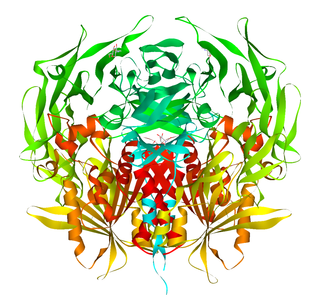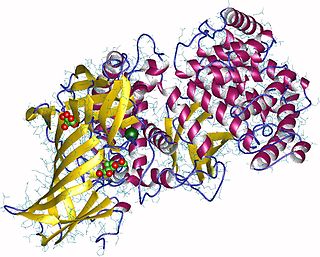Related Research Articles

Membrane alanyl aminopeptidase also known as alanyl aminopeptidase (AAP) or aminopeptidase N (AP-N) is an enzyme that in humans is encoded by the ANPEP gene.

Dipeptidyl peptidase-4 (DPP4), also known as adenosine deaminase complexing protein 2 or CD26 is a protein that, in humans, is encoded by the DPP4 gene. DPP4 is related to FAP, DPP8, and DPP9. The enzyme was discovered in 1966 by Hopsu-Havu and Glenner, and as a result of various studies on chemism, was called dipeptidyl peptidase IV [DP IV].

Aminopeptidases are enzymes that catalyze the cleavage of amino acids from the amino terminus (N-terminus) of proteins or peptides (exopeptidases). They are widely distributed throughout the animal and plant kingdoms and are found in many subcellular organelles, in cytosol, and as membrane components. Aminopeptidases are used in essential cellular functions. Many, but not all, of these peptidases are zinc metalloenzymes.

Prolyl isomerase is an enzyme found in both prokaryotes and eukaryotes that interconverts the cis and trans isomers of peptide bonds with the amino acid proline. Proline has an unusually conformationally restrained peptide bond due to its cyclic structure with its side chain bonded to its secondary amine nitrogen. Most amino acids have a strong energetic preference for the trans peptide bond conformation due to steric hindrance, but proline's unusual structure stabilizes the cis form so that both isomers are populated under biologically relevant conditions. Proteins with prolyl isomerase activity include cyclophilin, FKBPs, and parvulin, although larger proteins can also contain prolyl isomerase domains.
Procollagen peptidase is an endopeptidase involved in the processing of collagen. The proteases removes the terminal peptides of the procollagen. Deficiency of these enzymes leads to dermatosparaxis or Ehlers–Danlos syndrome.

Prolyl endopeptidase (PE) also known as prolyl oligopeptidase or post-proline cleaving enzyme is an enzyme that in humans is encoded by the PREP gene.

Leucyl aminopeptidases are enzymes that preferentially catalyze the hydrolysis of leucine residues at the N-terminus of peptides and proteins. Other N-terminal residues can also be cleaved, however. LAPs have been found across superkingdoms. Identified LAPs include human LAP, bovine lens LAP, porcine LAP, Escherichia coli LAP, and the solanaceous-specific acidic LAP (LAP-A) in tomato.

Procollagen-proline dioxygenase, commonly known as prolyl hydroxylase, is a member of the class of enzymes known as alpha-ketoglutarate-dependent hydroxylases. These enzymes catalyze the incorporation of oxygen into organic substrates through a mechanism that requires alpha-Ketoglutaric acid, Fe2+, and ascorbate. This particular enzyme catalyzes the formation of (2S, 4R)-4-hydroxyproline, a compound that represents the most prevalent post-translational modification in the human proteome.

Xaa-Pro dipeptidase, also known as prolidase, is an enzyme that in humans is encoded by the PEPD gene.

Dipeptidyl-peptidase 2 is an enzyme that in humans is encoded by the DPP7 gene.

Xaa-Pro aminopeptidase 1 is an enzyme that in humans is encoded by the XPNPEP1 gene.

Dipeptidyl peptidase I is an enzyme. This enzyme catalyses the following chemical reaction
Tripeptide aminopeptidase is an enzyme. This enzyme catalyses the following chemical reaction:
Xaa-Pro aminopeptidase is an enzyme. This enzyme catalyses the following chemical reaction
Xaa-Trp aminopeptidase is an enzyme. This enzyme catalyses the following chemical reaction
Aminopeptidase S is an enzyme. This enzyme catalyses the following chemical reaction
Xaa-Pro dipeptidyl-peptidase (EC 3.4.14.11, X-prolyl dipeptidyl aminopeptidase, PepX, X-prolyl dipeptidyl peptidase is an enzyme. It catalyses the following chemical reaction
Xaa-Xaa-Pro tripeptidyl-peptidase is an enzyme. It catalyses the following chemical reaction
Membrane Pro-Xaa carboxypeptidase is an enzyme. This enzyme catalyses the following chemical reaction
Pyroglutamyl-peptidase I (EC 3.4.19.3, also known as Pyrrolidonyl peptidase, is an enzyme found in bacteria, plants and animals.
References
- ↑ Sarid S, Berger A, Katchalski E (July 1962). "Proline iminopeptidase. II. Purification and comparison with iminodipeptidase (prolinase)". The Journal of Biological Chemistry. 237 (7): 2207–12. doi: 10.1016/S0021-9258(19)63420-4 . PMID 14497218.
- ↑ Nordwig A, Mayer H (April 1973). "The cleavage of prolyl peptides by kidney peptidases. Detection of a new peptidase capable of removing N-terminal proline". Hoppe-Seyler's Zeitschrift für Physiologische Chemie. 354 (4): 380–3. doi:10.1515/bchm2.1973.354.1.380. PMID 4803482.
- ↑ Turzynski A, Mentlein R (July 1990). "Prolyl aminopeptidase from rat brain and kidney. Action on peptides and identification as leucyl aminopeptidase". European Journal of Biochemistry. 190 (3): 509–15. doi: 10.1111/j.1432-1033.1990.tb15603.x . PMID 2373079.